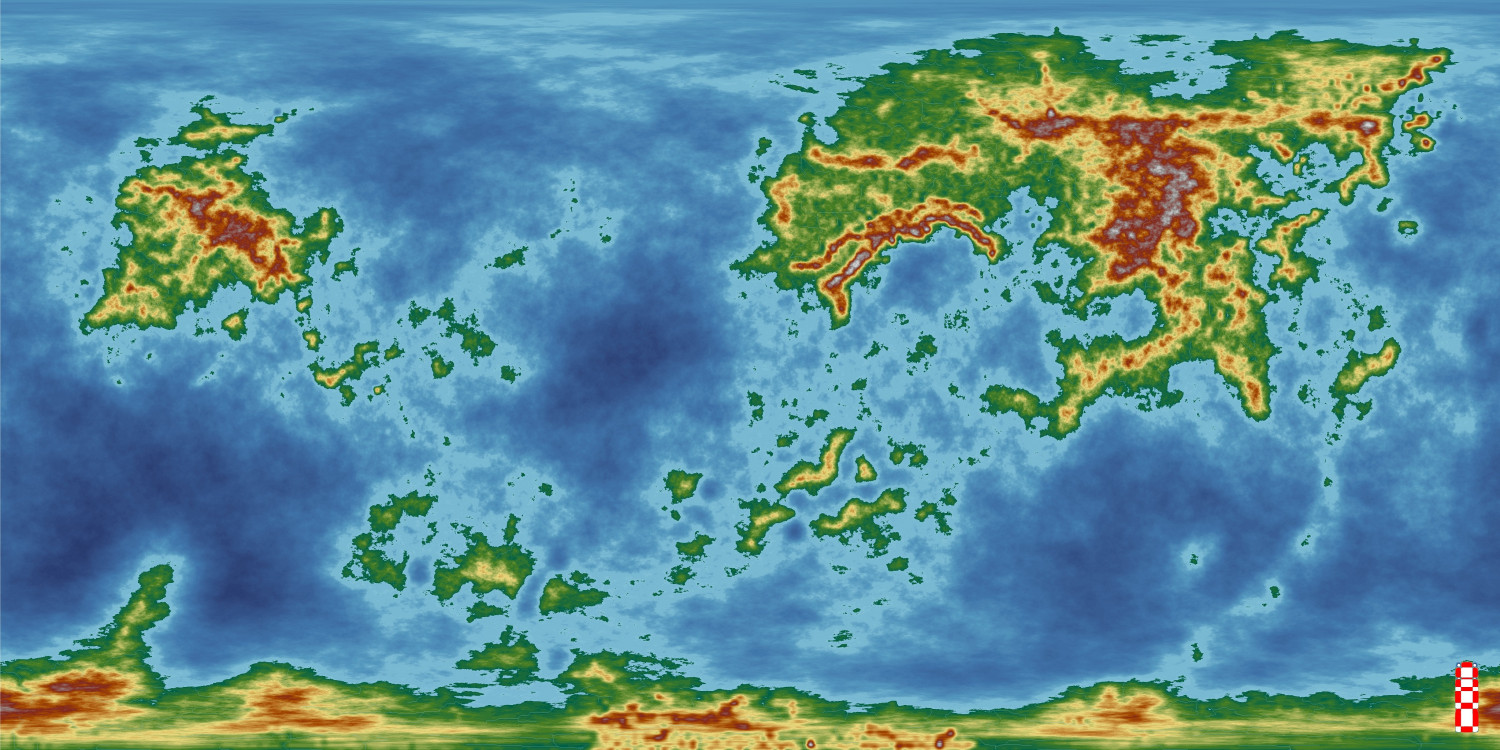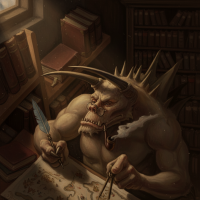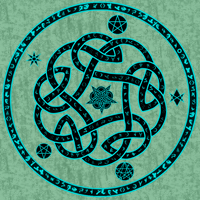Ukadarlia
I have started on a project which I hope will get published next year. It is set on the continent of Ukadarlia on the world of Dashamargo, with the initial focus being on the NE of the continent, and the nation of Kelenahavan in particular.
These are the maps so far. In addition there will be geographical, historical, political and cultural notes, as well as notes on the various races, ethnicities, fauna and flora and unique 'monsters'. As well, I hope there will be at least 2o adventures, with a common thread to make a full campaign, as well as many other adventure hooks, and character profiles.
Anyway, here is a map of the world, as created in FT3.









Comments
Here is the continent of Ukadarlia, stretching for subarctic to tropical zones. Also, for comparison, the size of Australia, and Ukraine.
Climate:
Altitude:
Ethnic:
And with Australia overlaid so you get an idea of the size:
Here is the NE area, with a zoomed in version as well.
Zoomed in further:
Finally, the main focus of the project:
The country of Zelenahavan (means Verdant Haven, or Greenharbour).
Two major ethnic groups: the Vynlings and the Kratirim, with all the tensions that this will imply.
More detail on this will come of course.
FYI:
1. Black – Swabentu - speak Swaheirian [Swahili]
2. Brown – Dingadau - speak Dingadoo [Maori]
3. Olive – Norvia - speak Norvian [Italian]
4. White –
a. Vynlings – speak Vinelandik [Icelandic]
b. Kratirim – speak Ukratina [Ukrainian]
c. Qesuik – speak Iluisq [Mongolian]
5. Aeifa (Elves) - tan skin - pseudo Irish
6. Davarin (Dwarves) - albino – pseudo Georgia
7. Grim (Orc) grey skin – pseudo Hungarian
8. Drakonis (Reptilian) - iridiscent colours as seen in beetles – pseudo Persian
The Vynlings - a Nordic-like people.
The Kratirim - a Slavic -like people
Amazing work love it. I can feel your imagination churning through the maps and peoples of the world as I look at it.
The male and female Swabentu - a South Sudanese- Masai -like people.
The male and female Norvians - rather pale green-olive skin, mediterranean types.
I may have made their heads a bit big for the bodies - i had to scale them different X and Y axis to get a more rounded face, rather than oval as is standard CA
All fixed to my satisfaction - except the scale of the man is a bit smaller than the woman - not so on the maps which will feature them, however.
The Qesuik - adapted for colder climes.
Revised characters. Hope this meets the comments below - I feel these are better as well.
Her nose looks a bit odd on my computer screen.
Yes, I have fixed it already. I may actually add tattoos to both their faces.
The two Drakona - these are derived from a completely different evolutionary path from humans-elves-orcs; and so cannot interbreed with them. Their wings allow them to glide more than actually fly, as they are almost a vestigial organ, and serve as sexual display, rather than functional. I would have liked to make them more iridescent, but CC3 doesn't have iridescent sheens - are there sheet effects that would allow this?
I have decided to make the Drakona 6 limbed - I am not so sure it works with CA, but this will do, I think
Interesting result.
I thought dragon types were six limbed anyway with the wings. Or don't you count them as limbs?
I am actually making them more on a insect template - this is a leather skinned, egg laying, reptilian creature, but with three parts to their body - head, thorax (with lungs) and abdomen (with tail) and six limbs and many of this group also have wings - certainly the sentient species does. A different evolutionary biology to reptiles and insects on earth, but combining features of both. They are actually the original land dwelling sentient species on this planet - the humans, elves and orcs derive from human species on Earth, stranded millennia ago on this planet, and evolving in different ways (helped by genetic modification in the very early years of human settlement - technology now lost to time). Dwarves, with radio-resistance, albino features, thin bodies and cat-like night vision, are derived from yet another planet, having settled the underground regions long before human arrival about 20,000 years ago.
So, not your standard Lizardman-dragon, or dwarf.
The Dinadao - a brown-skinned race, mainly living in the tropics.
The Davaraz - the 'dwarves' of Ukadarlia. They are albino with green cat's eyes and night vison. They are also radio-resistant, and love using uranium and cobalt in their metal work! They predate human arrival on Dashamargo by about 15,000 years at least, and are from another planet, not earth. And so cannot interbreed with human stock - hence no half-dwarves or half-davaraz.
The Aeifa - 'elves' of Ukadarlia. These really are just a human variant, though more so than the other human ethnic groups. They have purple eyes, and can see into the UV range; they nearly always have red hair; and are very tall and very thin. They have extended life spans up to 300 years, due to biochemical changes that slow aging.
Finally, the Grimir - the 'orcs' of Ukadarlia. They have grey skin and protruding lower canines. They are otherwise another human variant. Both the Aeifa and Grimir can interbreed with each other and the other human ethnicities; however, the pregnancies are likely to miscarry about 50% of the time, and the progeny have about a 20% chance of a genetic flaw - eg cleft lip, club foot, extra digit, accessory nipples, large birthmarks, etc.
And finally, here are all the races, with their relative heights.
And here is the final Ethnic map of Ukadarlia.
Love this!!!!!
Nice work there.
Some background.
The original sentient inhabitants of Tatilana were the Drakona and the Muru
The Drakona are six-limbed creatures, with a pair of wings, and a tail. Their body is segmented into three distinct parts –
a) The head, which has almost 230o rotation, and contains the organs of taste, smell and sight and hearing, along with the brain.
b) A thorax which contains 2 lungs, and a heart and electric organ responsible for creating the energy for manipulation of the electromagnetic spectrum, and another organ responsible for immune responses. The upper four limbs are attached to the thorax, and the digits have special nerve endings that enable the direct use of electromagnetic energy.
c) An abdomen, which contains
a. the alimentary canal
b. a purifying organ – combining functions of a kidney, liver and spleen.
c. various hormone producing organs,
d. the organ which produces the blood cells responsible for transporting oxygen.
e. the sexual organs which produce the gametes for reproduction, and the equivalent of a uterus for both sexes, which are both able to lay eggs.
f. a tail attached which has poison spurs on it. The toxins produced mainly causing neuro-paralysis.
g. The lower two limbs, which enable it to walk upright
h. A pair of wings, which are only useful for gliding. Their main function seems to be in sexual display. The female has fairly plain, usually shades of green, wings, while the male sports larger wings with various iridescent colours of blue, red, green and purple (rather like the colourful beetles of Earth).
Their ‘skin’ is light weight chitinous material (similar to insects on earth), which is also very hard, and acts as an exoskeleton – they do not have bones. There is a patch of leathery skin on their front abdomen, and the joints between the head, thorax and abdomen allow for flexible movement.
They live mainly in tropical and subtropical regions, as they are somewhat cold-blooded. Their blood is yellow, due to the pigment used to carry oxygen in their circulatory system. They are omnivorous, and love cooking complicated recipes.
They reproduce by egg-laying, and have a two stage life cycle – they are a larval form, which then hardens, and from that emerge fully developed Drakona, which in turn lay eggs which hatch larva. About 1 in 10,000 develop into huge dragon-like creatures, with huge wings that enable proper flight. They are thankfully sterile, but are capable of inflicting great damage.
They have a complex social system, and their language is both sibilant and harsh. They had developed to an early urban civilization by the time of the arrival of humans – see below.
The Muru are a totally marine race, inhabiting the depths of the oceans, with one subspecies adapted for shallow waters. They have a preference for colder waters, but migrate to equatorial latitudes for breeding. They have streamlined bodies, and four limbs used for grasping, and two vestigial legs. They are covered by a thin chitinous exoskeleton and have gill-like structures and an ability to extract oxygen from water. They have a semi-urbanized civilization and herd other marine animals. They are totally carnivorous, and use their electromagnetic abilities to obtain and prepare food. Their body pattern follows that of the Drakona.
From an evolutionary aspect, the Muru derived from marine genera, that also gave rise to land dwellers, and eventually the Drakona, in the same way fish gave rise to land dwelling animals on earth.
Arrival of the Davaraz
About 25,000 years ago, a colonizing spacefaring rave of Davaraz landed on Tatilana. They were an albino, radiation-resistant, race of small stature, adapted for underground dwelling. As a result, they did not compete with the Drakona or Muru, and instead hollowed out realms beneath the mountains, and had some perfunctory trade with the above land dwelling Drakona. How this underground race ever developed space travel is unknown, but may have had something to do with their fondness for working with such materials as uranium and thorium and cobalt – which evidently were in plentiful supply in their home world.
The Davaraz are about 1.2 m tall, four limbed, hairless except for beards on the males and a long ropy strand of thick hair on the females. They are a very pale white, with skin similar to humans, eyes which are large, green irises, and very well adapted to night and underground vision. They tend to be blinded by any normal lighting, and get severely debilitating pain if encountering bright light. As mentioned above, they are very radio-resistant, with their cells being surrounded by cell walls that protect the genetic material within from being subject to radiation damage.
Arrival of Humans
About 15,000 years ago, a colony ship of humans with thousands of frozen embryos, crash-landed on Tatilana, on the Ukadarlia continent. They had already used some genetic midifying techniques on various humans, and this continued after they established their first base on Ukadarlia. They were aggressive against the native Drakona, and soon a long war raged between the two races.
Towards the end of this 100 year conflict, the humans developed more modifications producing the strong war-like carnivorous and cannibalistic Grimir (orc-like), and the long-lived, somewhat self-repairing Aeifa, who could regrow limbs.
The main modifications made involved all the human races – first, an ability to metabolize sulphur better, as this planet has a higher concentration of sulphur in its make up than earth, which affected all living things. So the modifications were applied also to animals and plants that the earthlings had brought with them, though few of these survived. Only potatoes, barley, sugarcane, and cacao plants flourished, along with a few other herb-like plants (at least there was chocolate, beer and rum); and of the animals, only camels and their relatives survived in numbers enough to flourish. Thes animals have subsequently been bred to fulfill many functions – beasts of burden, war animals, pets, dairy and meat providers, wool providers, etc. Many of these functions had already been apparent in the versatile camel, but were greatly improved and enhanced, resulting in camels as big as elephants, and as small as medium dogs.
The second modification was to replicate the ability to use various wavelengths of the electromagentic spectrum in all humans. However, it seemed this ability was expressed mainly in females, as it was expressed on the X chromosome as a recessive suite of genes, requiring two X chromosomes to actually express the ability, although a few males did also have some albeit weak, ability in what came to be called etherics. This naturally led to a female-centric society, and eventually matriarchal systems of various types dominated the whole of the human races.
At the final stroke, the humans decided to cool the climate enough to destroy enough of the Drakona sufficiently to enable the humans to take over their lands with ease. But the project went awry, and the result was a cataclysmic Ice age, which almost wiped out the Drakona, and severely depopulated the humans. Most of developed technology was lost, and a rapid decline of civilization began.
After about 5000 years, the Ice Age retreated, and both humans and to a lesser extent, the Drakona, recovered and began to rebuild their civilizations.
TLDR: But WOW! Amazing work @Quenten .
Thanks Jim - not sure what TLDR means though. 😃
Too long, didn't read. It's internet acronyms :)
Awesome stuff there, Q.
Oh... I thought it had something to do with 'Ducking and Running'.